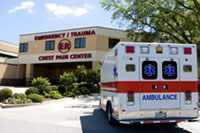 The most recent statistics available from the Centers for Disease Control and Prevention indicate that 129.8 million Americans visit the emergency room each year. Of those, 37.9 million are occasioned by injury, and 13.3 percent result in hospital admission.
The most recent statistics available from the Centers for Disease Control and Prevention indicate that 129.8 million Americans visit the emergency room each year. Of those, 37.9 million are occasioned by injury, and 13.3 percent result in hospital admission.
Trauma accounts for many of those hospitalizations. According to the American Association for the Surgery of Trauma, trauma is the leading cause of death for individuals up to the age of 45 years, and the fourth leading cause of death overall for all ages. Traumatic brain injury is the single largest cause of death from injury in the US.
In this issue, we look at the different but related disciplines of emergency medicine and trauma care. Summer seems a particularly apt time to look at these practice areas: it’s estimated that emergency room visits increase by as much as 20 percent in the warmer months, when people are likely to be far more active, pursuing outdoor activities like biking, swimming, skateboarding, playing sports, mowing grass and cooking out.
In Hampton Roads, that’s particularly true, with our beaches, parks, hiking trails and other attractions: our normal population base of 1.7 million swells to as much as 2.7 million in the summer, given the number of tourists who come to enjoy our various vacation destinations. Those additional million people are just as likely to suffer sudden illness and significant injury as native Hampton Roads residents. Whether they sustain a cat scratch, have a cardiac event or survive a hurricane, they need immediate care to avoid further harm.
 The three physicians who were chosen by our Physician Advisory Board from the many nominations submitted are self-described “adrenalin junkies” – they thrive in the fast-paced, demanding world of treating people who are in extremis. Their ability to respond to any and every situation that presents – to stabilize, diagnose and treat patients, and when indicated, refer them for advanced care – can make all the difference in a patient’s outcome.
The three physicians who were chosen by our Physician Advisory Board from the many nominations submitted are self-described “adrenalin junkies” – they thrive in the fast-paced, demanding world of treating people who are in extremis. Their ability to respond to any and every situation that presents – to stabilize, diagnose and treat patients, and when indicated, refer them for advanced care – can make all the difference in a patient’s outcome.
Emergency Medicine
The International Federation for Emergency Medicine (IFEM) defines the specialty as “concerned with the stabilization, management, diagnosis, and disposition of individuals with acute illness and injury. It also includes the management of trauma resuscitation, advanced cardiac life support, advanced airway management, poisonings, pre-hospital care and disaster preparedness. Emergency Medicine encompasses a large amount of general medicine but involves the technical and cognitive aspects of virtually all fields of medicine and surgery including the surgical sub-specialties.”
Physicians who practice emergency medicine, whether in the ER or as a first responder at a crisis scene, must have a broad knowledge base, with the skills of many specialists. In one day, they may be required to manage an airway, suture a laceration, treat a bone fracture, deliver a baby, stop a nosebleed or take care of a heart attack patient. Many ER physicians complete fellowships that include toxicology, pediatric medicine, sports medicine, critical care, ultrasound and other specialties.
In the US, the IFEM continues, the emergency department serves as the only access to medical care for millions of people. “As a result,” the report reads, “in addition to delivering the highest quality of medical care, the emergency physician’s practice includes elements of public health, population health, and prevention. This may include screening, intervention, treatment and referral for a variety of illnesses and behaviors such as substance use disorders, interpersonal violence, depression and other mental health disorders, and undiagnosed illnesses such as hypertension, diabetes, and HIV.”
Trauma
Categorizing the discipline of trauma care can be challenging. Trauma surgeons treat patients with sudden illnesses that require immediate surgical intervention, such as acute appendicitis, pancreatitis or gall bladder attacks. They take care of burn victims at any level of severity. They treat injuries of every conceivable etiology, whether auto accidents, workplace incidents, falls or injuries sustained at home – even abuse or other criminal violent acts. Thus all trauma surgeons are by definition intensive care doctors.
Additionally, over the past 10 years, there’s been a shift in terminology; that is, the discipline was formerly referred to collectively as trauma, or trauma and burns. Today’s more contemporary thinking is to consider trauma, burns and emergency general surgery as three subcategories that fall under the overarching discipline of Acute Care.
 The National Institutes of Health recently described the specialty of trauma surgery as ‘evolving,’ elaborating: “The continued decline in general surgery operative interventions in trauma patients has led to an exodus of promising young surgeons away from the field. A concurrent decline in the number of burn surgeons, as well as orthopaedists and neurosurgeons interested in providing emergency care, led to a pressing need for surgeons able to perform emergency surgical care. In addition, the general surgery workforce has followed a trend of increased specialization, with young surgeons gravitating toward specialties that are perceived to have a more forgiving lifestyle. This development has led to troublesome gaps in the emergency surgery call schedule at many institutions. Several intrepid centers already have begun assimilating acute care surgery into their departments with impressive results for their patients. Increased operative volume, increased reimbursements, and a palatable lifestyle add to the allure of treating these complex and interesting patients. Training future surgeons to staff the ranks of acute care surgery is an important and exciting challenge.”
The National Institutes of Health recently described the specialty of trauma surgery as ‘evolving,’ elaborating: “The continued decline in general surgery operative interventions in trauma patients has led to an exodus of promising young surgeons away from the field. A concurrent decline in the number of burn surgeons, as well as orthopaedists and neurosurgeons interested in providing emergency care, led to a pressing need for surgeons able to perform emergency surgical care. In addition, the general surgery workforce has followed a trend of increased specialization, with young surgeons gravitating toward specialties that are perceived to have a more forgiving lifestyle. This development has led to troublesome gaps in the emergency surgery call schedule at many institutions. Several intrepid centers already have begun assimilating acute care surgery into their departments with impressive results for their patients. Increased operative volume, increased reimbursements, and a palatable lifestyle add to the allure of treating these complex and interesting patients. Training future surgeons to staff the ranks of acute care surgery is an important and exciting challenge.”
In Hampton Roads, both residents and visitors alike can be assured that the emergency and trauma care readily available throughout the community is second to none in the country.

